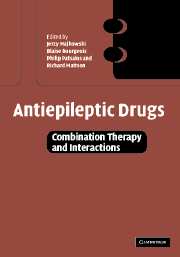Book contents
- Frontmatter
- Contents
- List of contributors
- Foreword
- Foreword
- Acknowledgements
- Part I Introduction
- Part II Pharmacokinetic interactions
- Part III Pharmacodynamic interactions
- Part IV Drug interactions in specific patient populations and special conditions
- 14 Antiepileptic drug interactions in children
- 15 Antiepileptic drug interactions in the elderly
- 16 Antiepileptic drug interactions in pregnancy
- 17 Antiepileptic drug interactions in handicapped and mentally retarded patients
- 18 Antiepileptic drugs and sex steroids
- 19 Antiepileptic drug interactions in patients requiring psychiatric drug treatment
- 20 Antiepileptic drugs in non-epileptic health conditions: possible interactions
- 21 Drug monitoring in combination therapy
- 22 Cognitive side-effects due to antiepileptic drug combinations and interactions
- Part V Conclusions and future perspectives
- Index
16 - Antiepileptic drug interactions in pregnancy
from Part IV - Drug interactions in specific patient populations and special conditions
Published online by Cambridge University Press: 07 September 2009
- Frontmatter
- Contents
- List of contributors
- Foreword
- Foreword
- Acknowledgements
- Part I Introduction
- Part II Pharmacokinetic interactions
- Part III Pharmacodynamic interactions
- Part IV Drug interactions in specific patient populations and special conditions
- 14 Antiepileptic drug interactions in children
- 15 Antiepileptic drug interactions in the elderly
- 16 Antiepileptic drug interactions in pregnancy
- 17 Antiepileptic drug interactions in handicapped and mentally retarded patients
- 18 Antiepileptic drugs and sex steroids
- 19 Antiepileptic drug interactions in patients requiring psychiatric drug treatment
- 20 Antiepileptic drugs in non-epileptic health conditions: possible interactions
- 21 Drug monitoring in combination therapy
- 22 Cognitive side-effects due to antiepileptic drug combinations and interactions
- Part V Conclusions and future perspectives
- Index
Summary
Scope of the problem
Women with epilepsy require chronic antiepilepsy drugs (AEDs) to prevent seizures, maintain their function and health. Unlike most young women they are unable to discontinue their medications if they become pregnant, for to do so increases their risk of seizures, personal injury, miscarriage and developmental delay in the offspring. With a prevalence of between 0.6% and 1.0% and an estimated 40% of those with epilepsy being women of childbearing years one can see that the potential public health impact is significant. Most women with epilepsy have healthy children but there is an increased risk for congenital malformations, fetal loss, developmental delay and neonatal hemorrhage. Maternal epilepsy is a contributor but the use of AEDs is a significant confounder. To make matters more complicated 86% of pregnant women take medications during pregnancy. A survey by the World Health Organization of 14778 women in 22 countries reported that of the 86% of women taking medications during pregnancy the average number of prescriptions was 2.9 (range of 1–15). This study did not evaluate over-the-counter medications. The preponderance of prescriptions, 73%, were written by obstetricians (Collaborative Drug Use in Pregnancy, 1991).
When evaluating AED use in pregnancy one is hampered by the lack of knowledge of specific co-medications, even though it is clear that this is a common event. While monotherapy with AEDs is a goal of epilepsy management, it is not always an obtainable one.
Keywords
- Type
- Chapter
- Information
- Antiepileptic DrugsCombination Therapy and Interactions, pp. 294 - 324Publisher: Cambridge University PressPrint publication year: 2005



